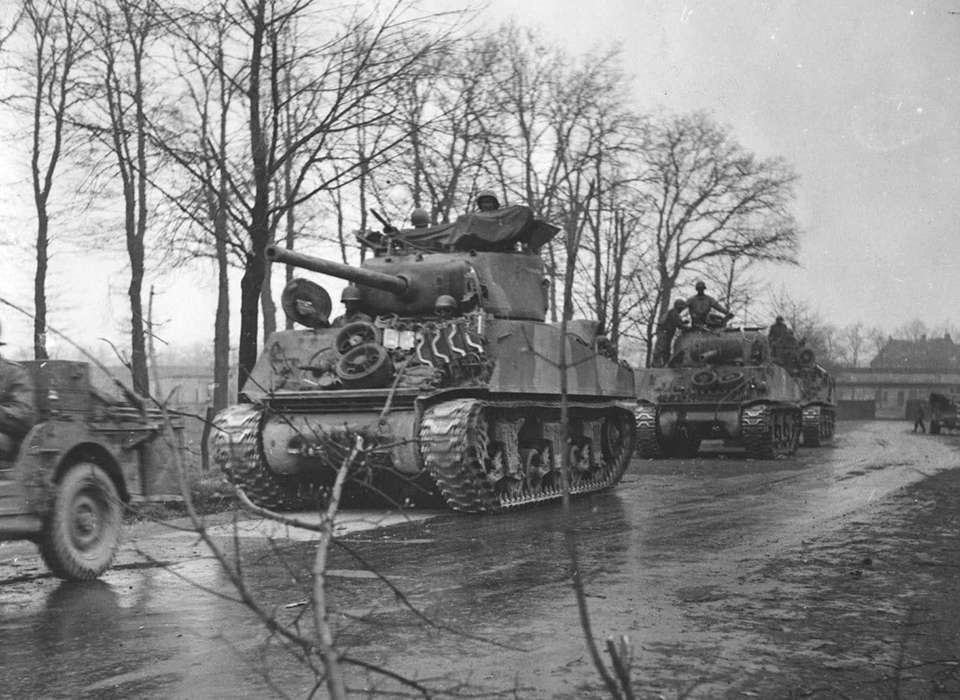| Black Panthers:
The Final Black Tank Battalion, Part 2
By Mike Bennighof, Ph.D.
August 2021
 Replacement personnel for the 784th Tank Battalion’s combat losses came from the pool of volunteers from Black service units that manned the “fifth platoons” assigned to white regiments. The U.S. Army had no training system for Black armor replacements (or any other branch); the Black combat units had not been intended to actually see combat. These men had received two weeks of refresher training, but no specialized instruction in tanks though at least many of them knew how to drive heavy trucks. Replacement personnel for the 784th Tank Battalion’s combat losses came from the pool of volunteers from Black service units that manned the “fifth platoons” assigned to white regiments. The U.S. Army had no training system for Black armor replacements (or any other branch); the Black combat units had not been intended to actually see combat. These men had received two weeks of refresher training, but no specialized instruction in tanks though at least many of them knew how to drive heavy trucks.
The battalion received enough new and repaired tanks to replace all of the 32 lost Shermans, but without sufficient trained crewmen they could not be fully manned. The battalion staff made do by eliminating the assistant driver from each five-man crew, which also took the bow machine gun out of operation. Many tanks also lost their loader, forcing the tank commander to perform that task as well. Those moves greatly reduced the efficiency of each tank, but spared the U.S. Army the horror of placing white and Black men together in a closed steel box. The tanks themselves now lost their standardization; like other independent tank battalions the 784th received whatever models the depots had available and now required both 75mm and 76mm ammunition resupply.
When the battalion returned to action in late March, it crossed the Rhine at Wesel on a pontoon bridge built by U.S. Army engineers following a cross-river assault by the 30th Infantry Division. By the 26th all three medium tank companies were in action, still in the infantry-support role, fighting the hastily-assembled alarm units the Germans had flung into their path. What changed now, and made the fighting extra deadly for tank units, was the deployment of the thousands of flak guns that had defended German industry from Allied air attack into front-line positions. With the steel and armaments plants now hopelessly shattered, they could be left undefended and the heavy guns wheeled into place alongside the militia. The 88mm and even more powerful 105mm high-velocity guns had a high profile and were terribly vulnerable to all types of American fire, and were often crewed by teenaged boys and girls. But they could effortlessly shred a Sherman tank.

Shermans of the 784th Tank Battalion advance into Germany.
The American lines held by 35th Infantry Division and the other formations of XVI Corps pressed against the Ruhr industrial district. By 28 March the division and its supporting 784th Tank Battalion stood less than 10 kilometers from Essen, seat of the Krupp industrial conglomerate. As they pressed forward, they fought from building to building through heavily industrialized zones, and encountered tens of thousands of nearly-starved slave laborers who had escaped the factories where they had been forced to work for German corporations like Volkswagen, Krupp, Daimler-Benz and Siemens.
American troops encircled the Ruhr on 1 April, trapping some 17 German divisions in the pocket. Through the first weeks of April, the 35th Infantry Division ground relentlessly forward into the Ruhr, steadily capturing the shattered remains of massive factory complexes. Overcast weather limited air support, but with Antwerp in Belgium now fully operational as a port, the division and its parent XVI Corps now had unlimited artillery ammunition at their disposal for the first time in the war. The gunners blasted anything the infantry requested, and blazed away at targets of opportunity when the infantry ran out of suggestions. The enemy-occupied zone in front of the advancing American divisions, already turned into a moonscape by years of Allied bombing, now was pulverized by a relentless 24-hour barrage of shells.
With the exception of a few days for rest and maintenance, the tanks of the 784th remained at the front, with one company of medium tanks attached to each infantry regiment – all three of which now fought in the front lines. The Germans had not yet abandoned resistance, and while the Americans swatted away a handful of weak attempts to break out of the pocket, the old men and boys dragooned into hastily-organized Volkssturm formations armed with ancient black-powder rifles and plentiful Panzerfaust rockets fought surprisingly hard, if not very well.
Two of the medium companies spent several days attached to the 17th Airborne Division, and participated in the capture of Essen. “Before we saw a target, the engaged it,” tank commander Sgt. Franklin Garrido recalled. “They jumped off our tanks hollering Geronimo! They were aggressive!”
By 12 April the Ruhr Pocket had been compressed enough to release the 35th Infantry Division and its supporting 784th Tank Battalion. The division now rushed to the Elbe River to meet the oncoming Red Army, with the African-American-manned truck companies of the Red Ball Express helping to move the infantry. Along the way they encountered still more escaped slave laborers, many of them dying from starvation along the roads even as they finally tasted freedom. At Gardelegen they rolled through a temporary holding facility just liberated by the 102nd Infantry Division; Nazi activists and German paratroopers had worked together to massacre over a thousand French and Polish prisoners of war, burning many of them to death before tossing the charred corpses into mass graves. Infuriated soldiers of the 102nd forced the townspeople at gunpoint to exhume the bodies and bury each one individually.

Tankers of the 784th ride the Tiger.
The 784th Tank Battalion suffered its last casualty on 18 April, when a Panzerfaust hit a Sherman and Henry Underwood burned to death inside. Underwood, a married 32-year-old from Cincinnati, had been one of the men to volunteer to leave a “safe” job in a service unit as soon as he arrived in Europe, so he could fight in a combat unit.
The battalion reached the Elbe River and halted, and soon met up with Soviet troops advancing from the east. At that point the 35th Infantry Division stood closer to Berlin than any other American unit. On 26 April the battalion and its parent division pulled back from the Elbe and took over occupation duty just east of Hannover. Five days later Adolf Hitler committed suicide, and within a week the dozen-year Reich had come to an end.
After brief training for possible use in the invasion of Japan, the battalion waited in France until December, when the men took ship for the United States. After a brief stay at Camp Kilmer, New Jersey, the 784th Tank Battalion de-activated in April 1946 and its men finally went home.
You can order Black Panthers right here.
Please allow an additional three weeks for delivery.
Sign up for our newsletter right here. Your info will never be sold or transferred; we'll just use it to update you on new games and new offers.
Mike Bennighof is president of Avalanche Press and holds a doctorate in history from Emory University. A Fulbright Scholar and NASA Journalist in Space finalist, he has published an unknowable number of books, games and articles on historical subjects.
He lives in Birmingham, Alabama with his wife, three children and his dog, Leopold.
Want to keep Daily Content free of third-party ads? You can send us some love (and cash) through this link right here. |
